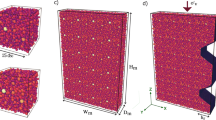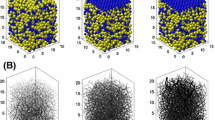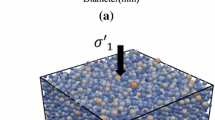Abstract
We search for a percolating, strong subnetwork of contacts in a quasi-statically deforming, frictional granular material. Of specific interest in this study is that subnetwork which contributes to the majority of the total deviator stress and is, or is on the edge of being, isostatic. We argue that a subnetwork derived from the minimal spanning trees of a graph—optimized to include as many elastic contacts as possible and which bear normal contact forces above a given threshold delivers such a network. Moreover adding the strong 3-force-cycles to the spanning tree introduces a level of redundancy required to achieve a network that is almost if not isostatic. Results are shown for assemblies of non-uniformly sized circular particles under biaxial compression, in two-dimensions: a discrete element (DEM) simulation of monotonic loading under constant confining pressure, and cyclic loading of photoelastic disks under constant volume.
Similar content being viewed by others
References
Tordesillas A., Muthuswamy M.: On the modeling of confined buckling force chains. J. Mech. Phys. Solids 57, 706–727 (2009)
Vardoulakis I.: Shear-banding and liquefaction in granular materials on the basis of a Cosserat continuum theory. Ingenieur-Archiv 59, 106–113 (1989)
Drescher A., de Josselin de Jong G.: Photoelastic verification of a mechanical model for the flow of a granular material. J. Mech. Phys. Solids 20, 337–340 (1972)
Majmudar T.S., Behringer R.P.: Contact force measurements and stress-induced anisotropy in granular materials. Nature 435, 1079–1082 (2005)
Zhang J., Majmudar T.S., Tordesillas A., Behringer R.P.: Statistical properties of a 2D granular material subjected to cyclic shear. Granul Matter 12, 159–172 (2010)
Tordesillas A., Walker D.M., Lin Q.: Force cycles and force chains. Phys. Rev. E 81, 011302 (2010)
Tordesillas A., Lin Q., Zhang J., Behringer R.P., Shi J.Y.: Structural stability and jamming of self-organized cluster conformations in dense granular materials. J. Mech. Phys. Solids 59, 265–296 (2011)
Tordesillas, A., Pucilowski, S., Walker, D.M., Peters, J., Hopkins, M.: A complex network analysis of granular fabric evolution in three-dimensions. Dynamics of Continuous, Discrete and Impulsive Systems-B: Applications & Algorithms, (in press)
Radjai F., Jean M., Moreau J.-J., Roux S.: Force distributions in dense two-dimensional granular systems. Phys. Rev. Lett. 77, 274–277 (1996)
Thornton C., Antony S.J.: Quasi-static deformation of particulate media. Phil. Trans. R. Soc. Lond. A 356, 2763–2782 (1998)
Thornton C.: Numerical simulations of deviatoric shear deformation of granular media. Geotechnique 50, 43–53 (2000)
Antony S.J., Kuhn M.R.: Influence of particle shape on granular contact signatures and shear strength: new insights from simulations. Int. J. Solids Struct. 41, 5863–5870 (2004)
Thornton C., Zhang L.: On the evolution of stress and microstructure during general 3D deviatoric straining of granular media. Geotechnique 60, 333–341 (2010)
Antony S.J.: Link between single-particle properties and macroscopic properties in particulate assemblies: role of structures within structures. Phil. Trans. R. Soc. A 365, 2879–2891 (2007)
Baz̆ant Z.P., Cedolin L.: Stability of Structures: Elastic, Inelastic, Fracture and Damage Theories. Oxford University Press, New York (2003)
Chakraborty, B., Behringer, R.P.: Jamming of granular matter. In: Encyclopedia of Complexity and System Science, 39, 4997–5021. (2009)
van Hecke M.: Jamming of soft particles: geometry, mechanics, scaling and isostaticity. J. Phys. Condens. Matter 22, 033101 (2010)
Liu A.J., Nagel S.R.: The jamming transition and the marginally jammed solid. Annu. Rev. Condens. Matter Phys. 1, 347–369 (2010)
Moukarzel C.F.: Isostatic phase transition and instability in stiff granular materials. Phys. Rev. Lett. 81, 1634–1637 (1998)
Ellenbroek W.G., Somfai E., van Hecke M., van Saarloos W.: Critical scaling in linear response of frictionless granular packings near jamming. Phys. Rev. Lett. 97, 258001 (2006)
Ellenbroek W.G., van Hecke M., van Saarloos W.: Jammed frictionless disks: connecting local and global response. Phys. Rev. E 80, 061307 (2009)
Wyart M., Silbert L.E., Nagel S.R., Witten T.A.: Effects of compression on the vibrational models of marginally jammed solids. Phys. Rev. E 72, 051306 (2005)
Liu A.J., Nagel S.R.: Nonlinear dynamics: jamming is not just cool any more. Nature 396, 21–22 (1998)
Blumenfeld R.: Stresses in isostatic granular systems and emergence of force chains. Phys. Rev. Lett. 93, 108301 (2004)
Blumenfeld R.: Stresses in two-dimensional isostatic granular systems: exact solutions. New J. Phys. 9, 160 (2007)
Arevalo, R., Zuriguel, I., Maza, D.: Topology of the force network in the jamming transition of an isotropically compressed granular packing. Phys. Rev. E 81, 041302 (2010)
Kruyt, N.P., Antony, S.J.: Force, relative-displacement, and work networks in granular materials subjected to quasistatic deformation. Phys. Rev. E 75, 051308 (2007)
Walker D.M., Tordesillas A.: Topological evolution in dense granular materials: a complex networks perspective. Int. J. Solids Struct. 47, 624–639 (2010)
Tordesillas A., Zhang J., Behringer R.P.: Buckling force chains in dense granular assemblies: physical and numerical experiment. Geomech. Geoeng. 4, 3–16 (2009)
Muthuswamy, M., Tordesillas, A.: How do interparticle contact friction, packing density and degree of polydispersity affect force propagation in particulate assemblies? J. Stat. Mech. Theory Exp. P09003 (2006)
Tordesillas A., Muthuswamy M.: A thermomicromechanical approach to multiscale continuum modeling of dense granular materials. Acta Geotechnica 3, 225–240 (2008)
Author information
Authors and Affiliations
Corresponding author
Rights and permissions
About this article
Cite this article
Walker, D.M., Tordesillas, A., Thornton, C. et al. Percolating contact subnetworks on the edge of isostaticity. Granular Matter 13, 233–240 (2011). https://doi.org/10.1007/s10035-011-0250-y
Received:
Published:
Issue Date:
DOI: https://doi.org/10.1007/s10035-011-0250-y




